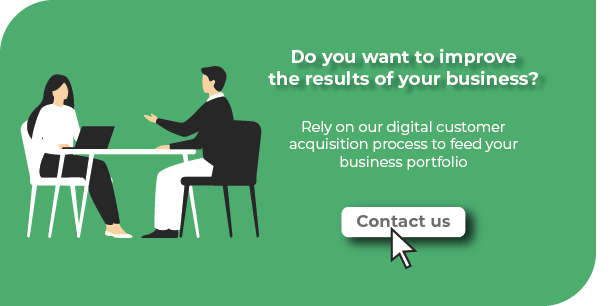Go to Market strategy is a planning strategy for entering new markets and searching for new commercial opportunities. At Vehnta, we are specialized in B2B and, after years of experience in creating contacts and in sales support, we have developed our active customer acquisition strategy that we have called the Bridge Strategy.
The Bridge Strategy is a process that uses digital tools to increase brand awareness and create engagement with the targets: it is a modular process consisting of six steps which can adapt to our customer’s business and commercial strategy.
The first two steps, called Branding and Reachability, are related to digital marketing and positioning; the major steps called Impact and Diving are more oriented to consulting and finding a direction for the new business activities, from which Go to Market strategy starts, while in conclusion, Get the ball rolling and Engage are steps dedicated to commercial push.
In the following post, we will then focus on the parts of the Bridge Strategy more related to sales: we will start from Impact and close with Engage.
The Go-to-Market strategy is part of our process, which will be defined in a specific paragraph, but it is included in the process of the Bridge Strategy.
Understanding the scenario: I as Impact
All the communication produced must result from the strategy linked to the Brand. It must be relevant and impact prospects. That does not translate into the obsessive search for originality but materializes instead to search for what is helpful for potential customers, of themes, language, and targets’ expectations.
For this reason, it is necessary to understand the scenario better and thus have an overview of the main stakeholders that make up the commercial process. At Vehnta, we suggest to our customers four steps: four tools to deepen the knowledge of their reality and to understand the reference scenario.
Impact tools are:
- Analysis of Purchasing System
- Competitor Analysis
- Target Analysis
- Definition of Personas
Let’s look at them in detail now.
Analysis of Purchasing System
The marketing & Sales process in B2B can be seen as a reversed pyramid: the highest point is the field of action of marketing, while the lowest part is the sphere of sales activity. This pyramid is divided into Prospecting and Qualify, usually of marketing competence, and into Cover the Basis and Close, usually of sales competence.
Below are the definitions of every step:
Prospecting – Activity of collecting leads with the purpose of generating new business opportunities through inbound or outbound marketing strategies
Qualify – Process to determine if a specific lead has specific characteristics that qualify it as a potential customer. These characteristics can be the authority, intention to purchase, and economic and technical dimensions of the company they represent.
Cover the Basis – Activity of collecting precise information by the people of the sales department. This information is related to potential clients. The process can start with receiving an NDA or technical specifications, a call, or a meeting.
Close – Phase of negotiation and closing of the deal
At Vehnta, we design the potential customer’s purchasing system, collecting information on the net and developing strategies to create insights starting from targeted initiatives. To obtain this design, after an analytical prospecting phase where we select several leads that gave feedback about their interest in an interaction, our mission is to identify the different figures that make up the purchasing system for each company among the contacts of the profiling phase.
These steps, however, in the B2B world, do not involve only two people, a seller and a buyer but, on the side of purchases and, therefore of the customer, the process provides a set of players who participate in all stages: it is a purchasing system.
Usually, a purchasing system in the B2B world is composed of 3 + 1 figures. That is an indicative and non-exhaustive number. It is indeed an indication of ever-present figures, which can be concentrated in a single person or a group of 4 or more people. At least, in theory, the critical issue is that these roles are always present, and an analysis of the purchasing system must take them into account. Below is a brief description of the figures:
Economic Buyer (EB) makes every choice by thinking about the ROI of every activity.
User Buyer (UB) uses and therefore really knows the product or service.
Technical Buyer (TB) applies the selection parameters provided by the EB.
Sponsor – Out of this scheme then remains the figure of the Sponsor, able to accelerate decisions or influence positively the entire agreement.
These 3 + 1 (Sponsor) figures compose the purchasing system and, depending on the purchase of the product/service in the negotiation phase. They could vary. A UB could become a TB in another situation, and so on. Indeed, the different corporate functions change their role in the system for each purchase. These figures, as listed, are not only the plastic representation of parts inside a decision-making process, but they are also the dynamic representation of the decision-making process that goes from the idea, passing through the technology, and finally reaching the selection parameters.
This pyramid, at its highest level, defines a phase of ideas and possible scenarios, which becomes the final choice with the shrinking of the funnel. Going down to the lower part, we indeed move closer to the final decision regarding time, but we have less scope for reasoning regarding content.
These figures are all involved, except for the Sponsor who can speed up the process, in a time flow that leads to the final choice: A flow that starts from a deep motivation, goes through a technological choice and arrives at the actual selection of the supplier according to the parameters that the previous levels have defined. Therefore, each figure is involved in a different decision-making phase and can thus be influenced by various information and contents.
The analysis of the purchasing system in Vehnta aims to outline the structure of the schema, identify the people who compose it, define their intention to purchase, and develop an action plan to start the engagement phase and to make relationships with targets more profound. This service is a fundamental part of a B2B business development strategy taught to lead generation and customer acquisition.
Competitor Analysis
Competitor Analysis, therefore, means the set of practical actions to define a context thanks to the collection of information. This information may be the most diverse, but it will serve as a trace to outline a situation: a particular moment in the market. Following are the primary tools for gathering information defined as a series of questions:
- Who are my competitors?
- How is it possible to describe my competitors in financial terms?
- How many employees do my competitors have?
- What are their prices?
- How does the sales force of my competitors act?
- What is their offer?
- What advantage do their potential customers target?
- What are their strengths and weaknesses?
- What drives customers to my competitors?
- What are their products?
- What is their customer acquisition strategy?
- How do they communicate?
- What is their digital strategy?
The tools listed above are only some of those that can be put in place for an in-depth Competitor Analysis. They are guidelines that will then be applied and tailor-made, and reworked for each industry. We at Vehnta are well aware that, especially for B2B, it is necessary to analyze every case, company, and market in detail.
In terms of Competitor Analysis, we can hence say that it is certainly necessary to draw and study the context, trying to reason in particular for each individual company, so as to obtain useful information to develop a new strategy, to identify the new potential target, to improve one’s space within the reference market and to better plan investments, both in strategic and active customer acquisition terms.
Target Analysis
By Target Analysis here in Vehnta, we, therefore, mean a process that will result in an ideal customer profile, in B2B terms intended as a company with, to follow as output, a list of the company that could become customers. The process for drawing up this list can be summarized in the following steps:
- Define the offer for a specific industry
- Define the competitive advantage
- Define the potential customer needs
- Analyze the problems of the potential customer the company can solve
- Draw the potential customer portrait
- Map the market looking for potential customers similar to the portrait of the potential customer
- List these potential customers by tracking the specific characteristics of each
- Develop a specific offer for each company on this list
Every list is a series of steps that have to be personalized accordingly to the company and the reference market. Therefore, the previous points are just an example of the work that has to be done in the Target Analysis phase to define a list of potential customers.
The expected result from Target Analysis is undoubtedly the material representation of the scenario: the draw of the playground with a focus on the various elements that make up the chessboard of a market. The output of the process will therefore be the analysis of the companies that make up a specific sector.
Definition of personas
Once the output of the previous point is defined, then the list of target companies with the analysis of the same. It will be necessary to go deeper and, as previously mentioned, move to the definition of the people who make up the purchasing system. However, to identify the people as part of the purchasing system, it is necessary to draw a portrait of all the actors involved: what in jargon is the definition of the personas?
In order to carry out a Definition of Personas that can help to draw plans and strategies with a decisive impact on commercial results, it is first of all necessary to have real, deep information derived from the experience of those in the company who are in constant contact with customers and potential customers. In fact, it is only through qualified information and insights that it is possible to define archetypes of people as part of the purchasing system. Therefore, for collecting this information, a decisive corporate effort, which can be considered the coordinated work between marketing, business developers, salesmen, project managers, and customer care, will be needed. The outlined profiles must consider information that, for an indicative and non-exhaustive list, can be clustered in personal details, character profile, and professional profile. Among the useful personal data, we find some that are reported by more traditional marketing, such as age, gender, geographical origin, level of instruction, and, if possible, also information on the family unit.
On the other hand, regarding character profile, it would be essential to draw a psychographic analysis to define personality, attitudes, mental patterns, and value system: thus defining what guides personal choices. By professional profile, in this case, here at Vehnta, we mean the relationship between the person and his company in terms of role, business goals, limits, needs, and priorities. This last part is fundamental to understanding the decision criteria as a company representative and the role, with the related responsibilities, in the purchasing system.
Once the Personas Definition activity has been carried out and the profiles of a purchasing system have been differentiated, it will be possible to try to apply the frame to target companies. Obviously, every case will differ from one another, especially in some B2B industries. Still, the definition of the buyer personas will always be of some help in defining the interlocutors and in choosing the most useful approach to achieve the goal.
Define the action plan: D as Diving
Once the scenario has been defined, it is necessary to go deeper into the commercial issues related to the market and determine an action plan: the real Go-to-Market Strategy. This part of Vehnta we call Diving.
Within the BRIDGE Strategy, Diving means analyzing every aspect of the situation of the market, the reference target, and the data collected through the actions of previous steps. It is a fundamental step, right in the central part of the strategy. Before this point, we worked on Brand, on the creation and distribution of contents, while in the following points, the Push phase begins: Diving, therefore, becomes the moment of reflection before action.
Strategia di Go-to-Market: introduction
The activities that compose the Go To Market activity offered by Vehnta materialize in 4 days. We will reflect together with the client this time: starting from the idea until realizing an analytical document. This document can then become a business plan accompanied by an action plan.
Step 1 – Value proposition and search for “why”
The aim is first to identify the value proposition of the new initiative. The value proposition is a commercial definition of the idea and its advantages for those who enjoy it. Then we will work on the company’s positioning and the identified target. The analysis will start from the ideal structuring of the target audience and from the illustration of the differentiating values of the activity. We will define to whom it is addressed and why and how it is different from other solutions already available on the market. This part will be characterized by the search of the fundamental “reason why” of the initiative and by the comparative analysis of the market, with a view to looking for new markets and new potential customers. To deepen the research of the “why,” here is an interesting link to the thought of Simon Sinek.
Step 2 – The different segments of potential customers
The work will continue with quantifying the different segments of potential customers in terms of numerousness, pricing, and relative services. The second step of this day will be based on the analyses necessary for the definition of a plan on the third day. We will start with the analysis of threats and opportunities. Then we will define strengths and points of emphasis concerning the proposed solution and the corrective actions. Finally, we will reach a structured comparative analysis of the advantages compared to other alternative solutions.
Step 3 – Operational actions
Using the work of identification of the first day and the analyses of the second day, we will start with the operational actions. The first part of the meeting will focus on designing the solution’s life cycle and the alternative solutions. It will continue with the product or service strategy and the relative marketing mix. Only then will be focused on drafting the business plan: costs, investments, ROI margins, and outline.
Step 4– Review and kick-off
The goal of the first three steps will be to describe the entire work and reflect on the steps to be taken shortly. It will be an open discussion on materials realized together in shared steps. The output of this day, so the whole process, will be an operational plan able to generate value for the company.
The value of defining together the Go-to-Market Strategy
The ‘Go-To Market’ activity result is an action plan accompanied by a business plan resulting from a shared analytical document. These outputs lead to the creation of commercial value for the customer intending to lead generation or customer acquisition. It is a structured and analytical process that allows us and the customer to think about the future in strategic and commercial terms. It is an opportunity to study one’s future and plan one’s own moves in advance.
Here at Vehnta, we help our customers vertically in terms of Strategic Consulting by offering them creative solutions that arise from our experience in different industries and the various personal experiences of our team. Our goal is to establish close collaborations with our customers to help their entire organization in the change phase: to express their potential. Change is never simple, but it is the only way to innovate: to trace the path to the future. In Vehnta, we believe that change is synonymous with evolution. To succeed in this constant transformation, we believe that continuous solutions are needed: following the paths already defined or being in total discontinuity with the past. Change is a source for creating new value: for this reason, we collaborate daily with our customers.
Therefore, strategic consulting for elaborating a Go-to-Market Strategy for us in Vehnta is searching for the best solutions that can create value for our customers through change intended as the solution. It is a particular activity: starting from the definition of a need, passing through the description of a plan to satisfy this need, to the choice of the requirements to reach the defined need to generate new value.
Act. Act. Act. G as Get the ball rolling
Once the analysis of the Impact phase and having built a Go-to-Market Strategy in the diving phase is put in place, you need to start playing. An Anglo-Saxon idiom gives the best idea of what we could translate as a Start.
An idiomatic expression gives the idea of what could be translated as the beginning. Not the beginning of activities or work, Get the Ball Rolling is the fifth step of Bridge Strategy, but instead the beginning of the scouting of commercial opportunities: an activity that can not be separated from the completion of the previous steps. A push activity, orchestrated in an expert way using the most advanced techniques to develop the first contact with potential customers.
Marketing Automation
The marketing automation activity proposed by us at Vehnta starts with the definition of the target in concert with the customer. The next step is the real objective of this activity: the profiling and the generation of a first connection with the defined contacts with the customer. As anticipated, in fact, this activity follows the definition of the Go to Market strategy, the definition of the purchasing system, and the search for contacts.
Starting from identifying the target together with the customer, the activity of marketing automation offered by Vehnta aims to profile and generate a first connection with the contacts defined with the client. As mentioned, this activity is subsequent to the definition of Go-to-Market strategy, the structuring of the Purchasing System, and the search for contacts.
Once the target has been identified, we will have to choose the tools to create the messages to be delivered and implement different paths conceived as touchpoints of the customer journey. Each activity will be shared with the customer to ensure a complete unit of attempts between the two parties.
After the campaign has been activated, we will manage the contacts and the email exchange with the interested targets. In this phase, positive and negative feedback and other insights that we will collect will be fundamental for the activity. Indeed, every input is helpful to confirm or to update the initial strategy, with a view to a cyclic optimization of the action: certainly marketing automation but, more in detail, the entire system of presence, positioning, and digital engagement.
After defining the most important data with the customer and adding the most meaningful metrics for us, the process by us in Vehnta defined special reporting process can begin. The first step will be to connect all the tools used for the activities of web presence, ADV, marketing automation, and management email outsourcing, comparing the data with the analyses carried out in the previous packages. In the second step, the contacts’ profiles will be deepened punctually.
CRM data will be processed together with data from direct email exchanges. All this data will be materialized in a report in a quick-to-understand format.
The main goal at Vehnta is to collect and verify the information to define whether the strategy is to be confirmed or updated. At the same time, the reading and analysis of these data can suggest valuable insights to implement other activities for continuous lead generation and customer research.
Creating qualified commercial: E as Engagement
The last step necessary to complete the BRIDGE Strategy, and therefore to achieve objectives of contact generation and beginning of a commercial relationship, is called Engage. At this stage, after the qualification of potential customers through the definition of messages, their distribution, and massive scouting through Marketing Automation, we move on to the personal relationship. This last step allows Vehnta to deliver to its customers’ Semi-finished contacts that salespeople can manage with a view to closing deals.
In Vehnta, we conceive the Commercial Support activity as an aid to the sales department of our customers. Our support consists of managing and executing various activities that our customers prefer to outsource to us. These activities range from creating company profiles and brochures to organizing small commercial events, such as workshops, passing through the management of more significant commercial events such as conferences and fairs, to managing the leads generated through active customer acquisition activities. This last point, in particular, is an integral part of the broader commercial strategy. To address the first contact with new leads is, in fact, a specialized activity in which the team of Vehnta can bring all its skills and commercial experience. The Commercial Support given by Vehnta to its customers means actual help: a necessary activity to safeguard resources in terms of staff, time, and energies to be employed on themes or aspects of negotiations that can become commercial value and thus deal.
After a first technical step connecting the accounts, the designated customer’s mail account will be used for activities related to marketing automation and all the feedback activities generated by it. The same account can be used for sending mass communications. In any case, all these activities will be agreed upon and defined with the customer, who will be able to control our work to ensure the maintenance of its standards.
Outsourced email management for our customers is an activity that empowers us and creates the right climate of trust that must be the cornerstone of a collaboration aimed at achieving important results. Managing a direct customer account is, in fact, essential to be able to interact with the targets in a timely and immediate manner.
Vehnta and the Go to Market Strategy: in conclusion
We at Vehnta, as from our mission as an active customer search company, help our customers vertically in terms of business advice. As mentioned above, we define with them the Commercial Development Plan that, inserted in the broader strategy, allows us to outline all the operations proper to generate commercial value.
For us, this business consulting activity is the last piece of our active customer search activity. We at Vehnta stop at the beginning of the commercial negotiation: once delivered to our customers’ semi-finished contacts, who have shown interest in the service by requesting a meeting or a quote, the commercial will be able to manage to close the deal. That is our specific choice. Helping companies generate commercial value without reaching the point of sale but working to create the conditions for sale.
Therefore, the commercial consultancy is oriented to improve sales performance to accompany our customers in the market more aware of their choices in terms of target and offer.
Would you like to know more? Contact us by filling in the form below.






